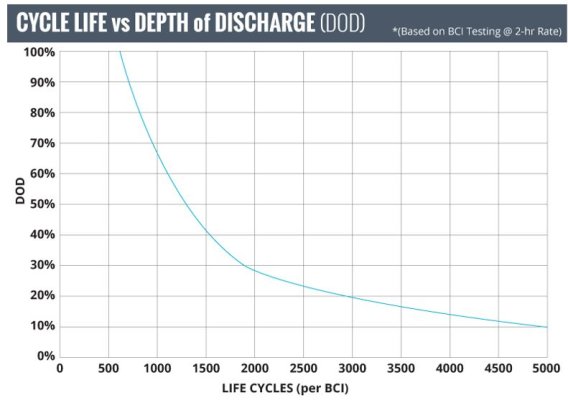Westiculo
Senior Member
- Joined
- Feb 27, 2017
- Messages
- 271
- Location
- US
- Vessel Name
- Rose Mary
- Vessel Make
- 42 Grand Banks Motoryacht - 1985
I had a realization recently that you get more battery life if you discharge the battery further (up to about 65% DoD)
Everybody always says the opposite; am I thinking about this wrong??
The chart below is for my batteries (full river 224-6).
For simple math, I have a 100Ah battery bank. If I discharge 67%, that's 67Ah - I'd get 1000 cycles before they die, so 67,000 total Ah.
If I choose to discharge much less, let's say 28%, that's 28 Ah - I'd get 2000 cycles before they die. That's 56,000 total Ah. Notice: THIS IS SIGNIFICANTLY LESS THAN ABOVE.
Deeper discharge: 67,000 lifetime Ah, shallower discharge, 56,000 lifetime Ah. What gives? I'm at anchor right now, could charge up every day (about 30% discharge), or every day (60% discharge), I'll get more life out of my batteries with the deeper discharge (not to mention less charge time).
For comparison I looked at the Trojan battery chart, and it makes no difference if you discharge 60% or 30%, the total lifetime Ah for their batteries is the same.
The takeaway: if I'm looking at this correctly, it's best for my batteries to discharge between 50% and 70%, not the 30%-50% range everybody tends to suggest. Also, none of this to mention the ability to have a smaller bank, which other people brought up in a different thread. Deeper discharge is less $$ and more convenience all around.
Everybody always says the opposite; am I thinking about this wrong??
The chart below is for my batteries (full river 224-6).
For simple math, I have a 100Ah battery bank. If I discharge 67%, that's 67Ah - I'd get 1000 cycles before they die, so 67,000 total Ah.
If I choose to discharge much less, let's say 28%, that's 28 Ah - I'd get 2000 cycles before they die. That's 56,000 total Ah. Notice: THIS IS SIGNIFICANTLY LESS THAN ABOVE.
Deeper discharge: 67,000 lifetime Ah, shallower discharge, 56,000 lifetime Ah. What gives? I'm at anchor right now, could charge up every day (about 30% discharge), or every day (60% discharge), I'll get more life out of my batteries with the deeper discharge (not to mention less charge time).
For comparison I looked at the Trojan battery chart, and it makes no difference if you discharge 60% or 30%, the total lifetime Ah for their batteries is the same.
The takeaway: if I'm looking at this correctly, it's best for my batteries to discharge between 50% and 70%, not the 30%-50% range everybody tends to suggest. Also, none of this to mention the ability to have a smaller bank, which other people brought up in a different thread. Deeper discharge is less $$ and more convenience all around.

